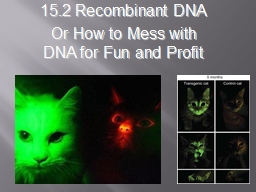

Profit What the heck is recombinant DNA Recombinant DNA is what you get when you combine DNA from two different sources For Example Mouse Human DNA Human Bacterial DNA Viral Bacteria DNA ID: 1045566
Download Presentation The PPT/PDF document "15.2 Recombinant DNA Or How to Mess with..." is the property of its rightful owner. Permission is granted to download and print the materials on this web site for personal, non-commercial use only, and to display it on your personal computer provided you do not modify the materials and that you retain all copyright notices contained in the materials. By downloading content from our website, you accept the terms of this agreement.
1. 15.2 Recombinant DNAOr How to Mess with DNA for Fun and Profit
2. What the heck is recombinant DNA?Recombinant DNA is what you get when you combine DNA from two different sources.For Example:Mouse + Human DNAHuman + Bacterial DNAViral + Bacteria DNAHuman + (other) Human DNAHuman + Spider DNA?
3. Why Make Recombinant DNA?Cure or treat diseaseGenetically modify our foods to increase flavor, yield, nutritional value, or shelf-lifeBetter understand human geneticsClone cells or organs
4. Polymerase Chain Reaction Once biologists find a gene, a technique known as polymerase chain reaction (PCR) allows them to make many copies of it. 1. @A piece of DNA is heated, which separates its two strands.@
5. Polymerase Chain Reaction 2. At each end of the original piece of DNA, a biologist adds a short piece of DNA that complements a portion of the sequence. These short pieces are known as primers because they prepare, or prime, a place for DNA polymerase to start working.
6. Polymerase Chain Reaction 3. @ DNA polymerase copies the region between the primers.@ These copies then serve as templates to make more copies.4. In this way, just a few dozen cycles of replication can produce billions of copies of the DNA between the primers.
7. What now since we have our copies of DNA?Cut DNA using restriction enzymesMix the cut DNA into other strand of DNA or the bacteria plasmid.Get new recombinantplasmid back into bacteria(Easy b/c bacteria take upDNA that’s floating around,known as transformation)
8. Combining DNA Fragments @Any piece of DNA cut with a certain restriction enzyme will “stick” to any other piece cut with that same RE@, even if they are different DNA pieces.
9. Plasmids and Genetic Markers @A genetic marker is a gene that makes it possible to distinguish bacteria that carry the plasmid from those that don’t.@ (Antibiotic resistant or fluorescence. This plasmid contains the antibiotic resistance genes tetr and ampr. Only those cells that have been transformed survive, because only they carry the resistance gene.
10. Plasmid DNA Transformation Using Human Growth Hormone
11. Transgenic Organisms How can genes from one organism be inserted into another organism?
12. Transgenic Organisms The universal nature of the genetic code makes it possible to construct organisms that are transgenic, containing genes from other species. @Transgenic organisms can be produced by the insertion of recombinant DNA into the genome of a host organism.@ Like bacterial plasmids, the DNA molecules used for transformation of plant and animal cells contain genetic markers that help scientists identify which cells have been transformed.
13. Transgenic Plants: Transforming a Plant with Agrobacterium
14. Cloning A clone s a member of a population of genetically identical cells produced from a single cell The technique of cloning uses a single cell from an adult organism to grow an entirely new individual that is genetically identical to the organism from which the cell was taken.Clones of animals were first produced in 1952 using amphibian tadpoles. In 1997, Scottish scientist Ian Wilmut announced that he had produced a sheep, called Dolly, by cloning.
15. Cloning Animals—Nuclear Transplantation